| From 16th July 2006 to 17th, I was invited to my friend Taka's wedding ceremony that was held in the suburbs of Kamphaeng Phet in Thailand. I would like to introduce this impressive marriage. | |
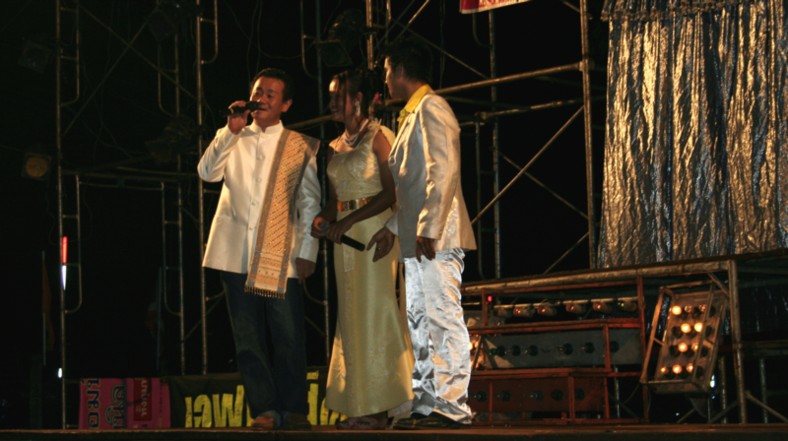
| |

Pink line is flight. Green line is taxi. |
15th July, I departed from the first terminal of Narita Airport in Japan by embarking on the flight TG643 of Thailand International Airways and arrived at Bangkok about 14:30 PM. It was a flight of six hours and a half, because difference in time was two hours between Thailand and Japan. Every passport controls counter of the airport had a long queue and I had to wait more than an hour because, in addition, examination per one person suffered for from one minute to two minutes. Meanwhile, a woman stranger who seemed to have come from Middle East and whose words I could not understand at all asked me how to fill out the column of entrance card by pointing it. The fact that I was often talked to by a foreigner didn't seem to be limited only in China. After that, I took a taxi, and I left airport for the Loyal Asia Lodge, Soi 8 Sukhumvit Bangkok. The driver often asked me in English, such as "Have you already booked the hotel? Till when will I be in Thailand?". This Thai driver seemed to be talkative. I checked in at the Loyal Asian Lodge. It cost US20$. And we got together at 5PM at the lobby of the Swiss Park Hotel where Taka, Toku, Yama and Kita had been already staying. And we went to a Thai restaurant. |
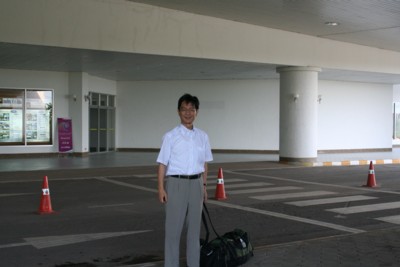
This is photo of waiting a taxi. |
Next morning I met Taka at lobby of the Swiss Park Hotel, and we left for Airport by taxi. Shanghai Chinese who were going to leave for Phuket called out me to, "Are you Japanese?". After that we embarked on the flight TG-160 of Thai Airways at 6:30 and left for Pitsanuloke. Pitsanuloke was located in the middle of Bangkok and Chiangrai. Inside of domestic line of Thai Airways was very colorful because color of cover of seats differed from each other. There was a taxi counter in the Pitsanuloke Airport. Taka negotiated the taxi fee from here to Kamphaeng Phet with a lady wearing suits behind the counter. Kamphaeng Phet was more than 100km west from here. After all, the fee was settled at 1500 BAHT (1BAHT nearly equal 3JPY). While waiting outside of the Airport, Toyota came there and the driver got off. We were surprised a little, because instead the woman who had been at the counter few minutes ago was marching into a driver's seat.
|
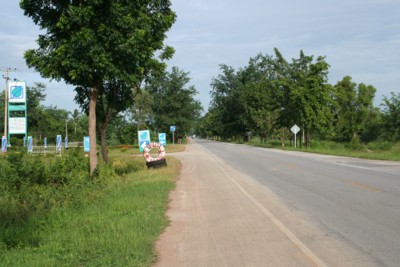 The road led to Kamphaeng Phet was very long and almost straight. The Miss receptionist-driver passed slow cars one after another. She said that we could not smoke in the car, so that we requested her smoking rest. At the time I took this picture. Suddenly I felt a stinging neuralgia on the left shoulder and on the left leg. Thinking result of everyday neglect of health was visited upon me, when we returned to the car, I noticed that several ants were biting my left shoulder and left leg. It's terrible. It seemed that ants had fallen down from trees' branches. I began to be worried in near future. After a while we reached the Phet Hotel, the most expensive hotel in Kamphaeng Phet that had been booked by Taka's fiancee Lady Kanung for Japanese visitors.
The road led to Kamphaeng Phet was very long and almost straight. The Miss receptionist-driver passed slow cars one after another. She said that we could not smoke in the car, so that we requested her smoking rest. At the time I took this picture. Suddenly I felt a stinging neuralgia on the left shoulder and on the left leg. Thinking result of everyday neglect of health was visited upon me, when we returned to the car, I noticed that several ants were biting my left shoulder and left leg. It's terrible. It seemed that ants had fallen down from trees' branches. I began to be worried in near future. After a while we reached the Phet Hotel, the most expensive hotel in Kamphaeng Phet that had been booked by Taka's fiancee Lady Kanung for Japanese visitors.
| 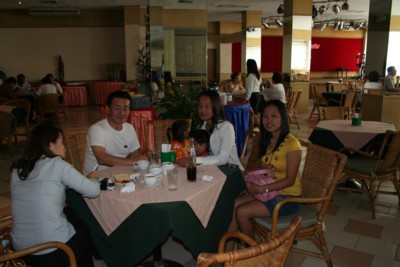 There I saw her for the first time. The second woman from the right was Taka's fiancee Lady Kanung. The first right was one of her closest friend from school days. She was very kind and she supported Kanung well until the ending of the wedding ceremony. The first left was Miss receptionist-driver. I wondered why she was having a tea with them. But she was negotiating with Kanung for our tomorrow return to Bangkok via Ayutthaya. Then the fee seemed to be fixed at 5,500 BAHT. Furthermore, they were arranging a car from Pitsanuloke to Kamphaeng Phet for Toku, Kita and Yama who would arrive by afternoon flight from Bangkok.
There I saw her for the first time. The second woman from the right was Taka's fiancee Lady Kanung. The first right was one of her closest friend from school days. She was very kind and she supported Kanung well until the ending of the wedding ceremony. The first left was Miss receptionist-driver. I wondered why she was having a tea with them. But she was negotiating with Kanung for our tomorrow return to Bangkok via Ayutthaya. Then the fee seemed to be fixed at 5,500 BAHT. Furthermore, they were arranging a car from Pitsanuloke to Kamphaeng Phet for Toku, Kita and Yama who would arrive by afternoon flight from Bangkok.
|
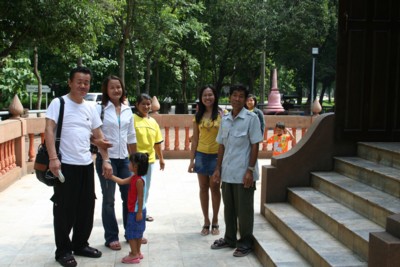 Kindly, Kanung took us to sightseeing of Kamphaeng Phet by so-called truck taxi. We prayed at a temple and went to museum afterwards. And Taka bought a gold necklace to present to Kanung on the way. Meanwhile, I bought several spit]roasted chickens, beers and rice at a street vender with her friend and ate by hand together on the bed of truck. Of course rice was Thai-rice that was wrapped in a saran wrap. Thai rice was so different from Japanese one that it was not sticky in a hand.
Kindly, Kanung took us to sightseeing of Kamphaeng Phet by so-called truck taxi. We prayed at a temple and went to museum afterwards. And Taka bought a gold necklace to present to Kanung on the way. Meanwhile, I bought several spit]roasted chickens, beers and rice at a street vender with her friend and ate by hand together on the bed of truck. Of course rice was Thai-rice that was wrapped in a saran wrap. Thai rice was so different from Japanese one that it was not sticky in a hand.
|
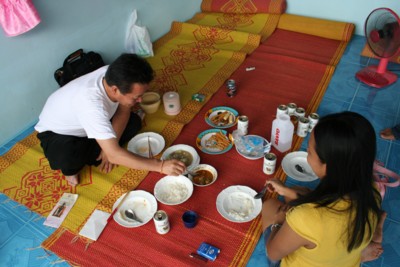 This picture was taken in the Kanug and Taka's new house.
I heard that this house had been constructed since this year began.
Soon after we reached this new house, we were treated with lunch.
We were also served with many cans of beer.
In Thailand, before entering the house, they seemed to take off their shoes same as Japanese.
But if there was difference between them, it was probably that there were some persons that were mainly children and the elderly who walked outside barefoot.
Thai dishes were very delicious if hsiang tsais such as coriander were not included.
I was fond of dry Thai rice very much for some reason.
This picture was taken in the Kanug and Taka's new house.
I heard that this house had been constructed since this year began.
Soon after we reached this new house, we were treated with lunch.
We were also served with many cans of beer.
In Thailand, before entering the house, they seemed to take off their shoes same as Japanese.
But if there was difference between them, it was probably that there were some persons that were mainly children and the elderly who walked outside barefoot.
Thai dishes were very delicious if hsiang tsais such as coriander were not included.
I was fond of dry Thai rice very much for some reason.
|
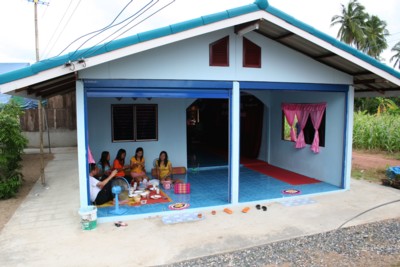 This was the new house of Kanung and Taka. It was an excellent house of the blue walls which wasn't really in the neighborhood. The front was shutters. I thought that these were closed at night, but in daytime these were being opened widely, and it looked like a happy and friendly house. Tiles of ceramics had been spread all over the floor and I felt chilly when I idled around, and I felt very comfortable.
This was the new house of Kanung and Taka. It was an excellent house of the blue walls which wasn't really in the neighborhood. The front was shutters. I thought that these were closed at night, but in daytime these were being opened widely, and it looked like a happy and friendly house. Tiles of ceramics had been spread all over the floor and I felt chilly when I idled around, and I felt very comfortable.
|
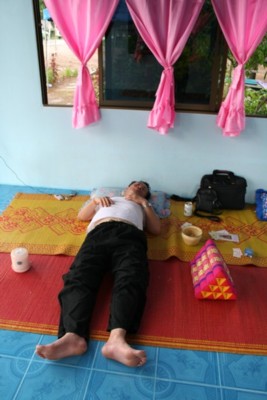 |
| I took a nap with Taka ramblingly because Kanung and her friend recommended us to take a nap eagerly. For health, it had been said in Japan that electric-fans should wag their necks. But somebody stopped them immediately when I let electric-fans wave their necks here. This nap was really comfortable. In this house, the places to lie down and to sit down were spread with some mats and some carpets appropriately. | |
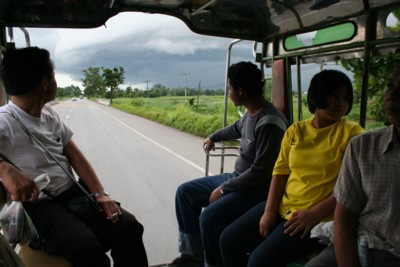 By the way, when nap was over, Kanung said to Taka that we should go to meet our friends. We came back to the Phet Hotel by the truck taxi and joined Toku, Kita and Yama of the late departure group. This photograph was taken from the truck taxi returning to the new home from the Phet Hotel. It took about 20 minutes from the city area to the new home. Dark clouds gradually caught up with us, and it started rain hard before long. Was this a squall? In spite of roof over the bed of truck, everybody was soaked by the rain.
By the way, when nap was over, Kanung said to Taka that we should go to meet our friends. We came back to the Phet Hotel by the truck taxi and joined Toku, Kita and Yama of the late departure group. This photograph was taken from the truck taxi returning to the new home from the Phet Hotel. It took about 20 minutes from the city area to the new home. Dark clouds gradually caught up with us, and it started rain hard before long. Was this a squall? In spite of roof over the bed of truck, everybody was soaked by the rain. |
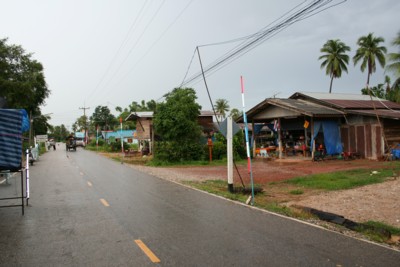 As rain became weak, I went out of new house and walked a little distance and photographed scenery of the village. The blue house above you see in the distance was the new house of Kanung and Taka. Almost all houses had space where villagers could gather in front of their house. In addition, many houses had a shop. After the squall became a slight rain, it became muggy very much.
As rain became weak, I went out of new house and walked a little distance and photographed scenery of the village. The blue house above you see in the distance was the new house of Kanung and Taka. Almost all houses had space where villagers could gather in front of their house. In addition, many houses had a shop. After the squall became a slight rain, it became muggy very much.
|
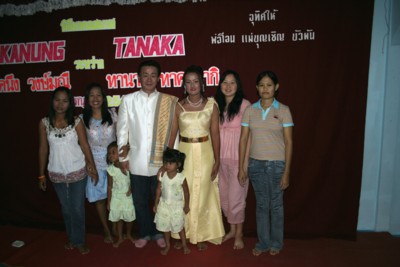 The day went down. So-called banquet (it would be the eve) was held in the night of the day before wedding here. The wedding ceremony seemed to be an early morning of the next day. The banquet had been ready.
The day went down. So-called banquet (it would be the eve) was held in the night of the day before wedding here. The wedding ceremony seemed to be an early morning of the next day. The banquet had been ready.
|
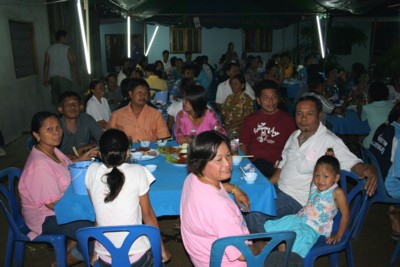 People of the village were gathering under the tents built in front of the houses. It seemed that the tables and seats had not been particularly assigned for certain persons beforehand, but friends who matched of their mind voluntarily would choose proper table and surrounded it. It was a pleasant gathering.
People of the village were gathering under the tents built in front of the houses. It seemed that the tables and seats had not been particularly assigned for certain persons beforehand, but friends who matched of their mind voluntarily would choose proper table and surrounded it. It was a pleasant gathering. |
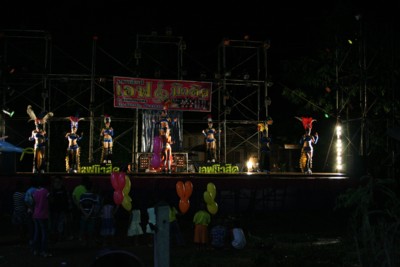 This was temporary stage that had been built in front of houses. Since past 7:00 to past 12:00, about ten professional dancers' dances and songs were continued without any rest. Japanese four people and the close friends of Kanung were offered nearest table to the stage. In spite of eager invitations of a certain lady to dance, I declined the proposal many times, but at last I joined the people dancing under the stage. All the people regardless of age or sex here were very fond of dancing.
This was temporary stage that had been built in front of houses. Since past 7:00 to past 12:00, about ten professional dancers' dances and songs were continued without any rest. Japanese four people and the close friends of Kanung were offered nearest table to the stage. In spite of eager invitations of a certain lady to dance, I declined the proposal many times, but at last I joined the people dancing under the stage. All the people regardless of age or sex here were very fond of dancing.
|
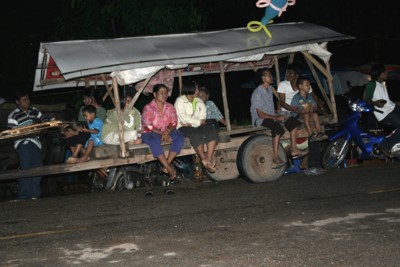 In this way the people who happened to pass here parked their carts on the road and saw the stage. They enjoyed the stage very much together until the midnight, too. It was the time for everybody to be able to relax, and to be happy.
In this way the people who happened to pass here parked their carts on the road and saw the stage. They enjoyed the stage very much together until the midnight, too. It was the time for everybody to be able to relax, and to be happy.
|
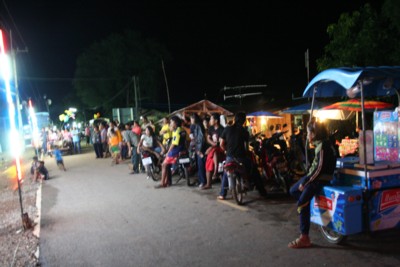 Though it was a part of wedding ceremony, street venders had gathered here. Ice creams, juices, balloons, liquors and beers were being sold.
Though it was a part of wedding ceremony, street venders had gathered here. Ice creams, juices, balloons, liquors and beers were being sold.
|
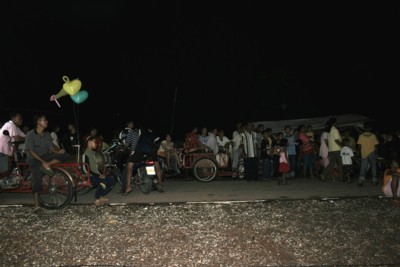 Thus people increased steadily from somewhere. The children who had a balloon also began to dance.
Thus people increased steadily from somewhere. The children who had a balloon also began to dance.
|
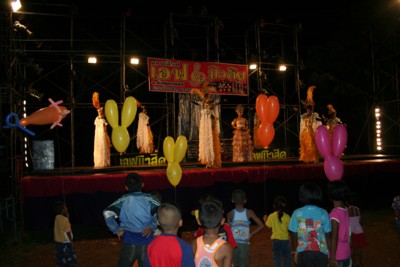 The stage was being continued, but Kanung and Taka sent us through a pitch-black road without light to Phet Hotel by a truck taxi before 12:00.
Next morning, we left the hotel at 6:30 for new home of Kanung and Taka. The wedding ceremony began at 7:30.
The stage was being continued, but Kanung and Taka sent us through a pitch-black road without light to Phet Hotel by a truck taxi before 12:00.
Next morning, we left the hotel at 6:30 for new home of Kanung and Taka. The wedding ceremony began at 7:30.
|
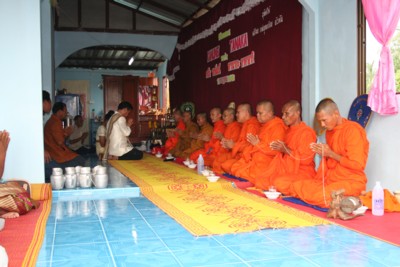 Nine Buddhist priests came over by cars. The Buddhist priests advocated a prayer to Buddha for a long time. Before long they were treated with meal. I thought it meant the end of this ceremony, but then prayers to Buddha began again.
Nine Buddhist priests came over by cars. The Buddhist priests advocated a prayer to Buddha for a long time. Before long they were treated with meal. I thought it meant the end of this ceremony, but then prayers to Buddha began again.
|
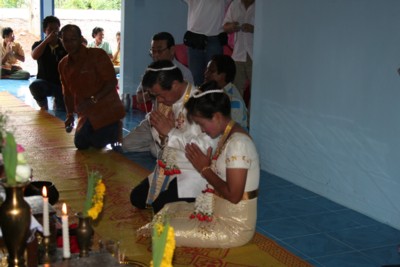 I did not really understand the meaning of this ceremony, but Kanung and Taka were praying eagerly. It was the solemnest time.
I did not really understand the meaning of this ceremony, but Kanung and Taka were praying eagerly. It was the solemnest time.
|
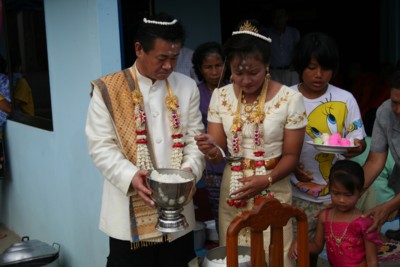 We distributed the rice that had caught a mercy by the prayer to Buddha of Buddhist priests into other rice bins being placed on the table outside little by little.
At first, the bride and the bridegroom, next Toku, next we Japanese and people of the village.
We distributed the rice that had caught a mercy by the prayer to Buddha of Buddhist priests into other rice bins being placed on the table outside little by little.
At first, the bride and the bridegroom, next Toku, next we Japanese and people of the village. |
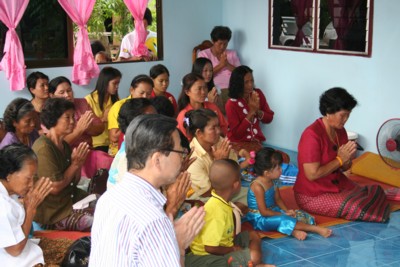 Only Japanese and mainly her relatives had come to the wedding ceremony on time, and her friends assembled in the latter half of a wedding ceremony. The thanks to Buddhist priests were dolly mixtures.
Only Japanese and mainly her relatives had come to the wedding ceremony on time, and her friends assembled in the latter half of a wedding ceremony. The thanks to Buddhist priests were dolly mixtures.
|
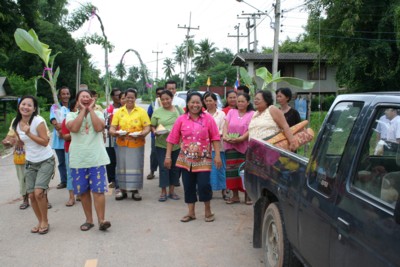 When Buddhist priests went back, Kanung and her relatives treated participants with breakfast. And presents were banana trees. Some of villagers who got a banana tree looked so glad as to begin to dance.
When Buddhist priests went back, Kanung and her relatives treated participants with breakfast. And presents were banana trees. Some of villagers who got a banana tree looked so glad as to begin to dance. |
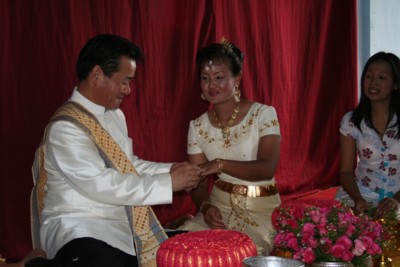 Then, we entered the house again. The bridegroom helped the bride into necklace, and put bridal ring through her finger.
The close friend of the bride always assisted her. And the bride's head and the bridegroom's head were connected by a white thread. It's very interesting, because in Japan we say that a bride and a bridegroom have been being connected by red thread since their births. But on the other hand in Thailand, was it white thread ?
Then, we entered the house again. The bridegroom helped the bride into necklace, and put bridal ring through her finger.
The close friend of the bride always assisted her. And the bride's head and the bridegroom's head were connected by a white thread. It's very interesting, because in Japan we say that a bride and a bridegroom have been being connected by red thread since their births. But on the other hand in Thailand, was it white thread ?
|
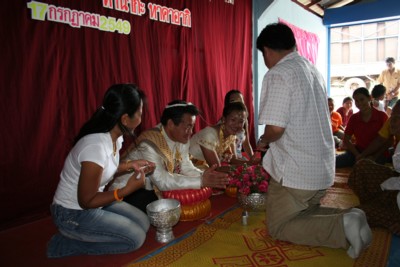 While wondering what would begin next, the ceremony of collection of celebration money began. The participants put money into a bowl in front of the couple before everyone was looking. It was different from Japanese manner. Japanese manner is that participants put money into envelope and write their name on it and hand it to receptionists. Less than 500BAHT seemed common. It was slightly strange that there were some persons getting the change.
While wondering what would begin next, the ceremony of collection of celebration money began. The participants put money into a bowl in front of the couple before everyone was looking. It was different from Japanese manner. Japanese manner is that participants put money into envelope and write their name on it and hand it to receptionists. Less than 500BAHT seemed common. It was slightly strange that there were some persons getting the change.
|
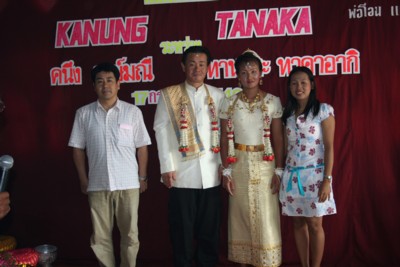 This was the finale of a wedding ceremony. Thank you Kanung, Taka and villagers. You two, everybody, long happiness! Before long the taxi Kanung had arranged arrived. While they saw us off, in front of excited local people, I got on a taxi with Toku and Kita, waving my hand again and again. I felt it was a moment hard to depart.
This was the finale of a wedding ceremony. Thank you Kanung, Taka and villagers. You two, everybody, long happiness! Before long the taxi Kanung had arranged arrived. While they saw us off, in front of excited local people, I got on a taxi with Toku and Kita, waving my hand again and again. I felt it was a moment hard to depart.
|
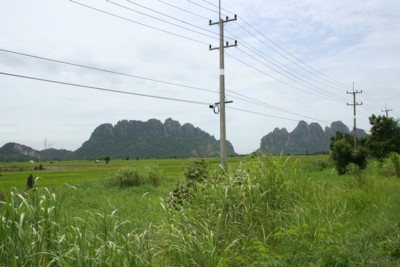 We went south straightly through National highway No. 1 and No. 32 to Bangkok for about 340km. In Nakhon Sawan prefecture, there were curious rocky mountains on the way and I photographed it from a window of a taxi.
We went south straightly through National highway No. 1 and No. 32 to Bangkok for about 340km. In Nakhon Sawan prefecture, there were curious rocky mountains on the way and I photographed it from a window of a taxi.
As well as road signs, there was not almost mention written in a language except Thai in the transport cafe we stopped by for lunch. We had to ask the driver to order a meal. The meal of here was delicious unexpectedly, too. |
| This taxi driver loves conversation, too. Because Japanese ate rice as well as the Thai, he seemed to have a sense of closeness very much with us. In Thailand, they ate not only by hand, fork and knife, but also by chopsticks. It's also the same as Japanese. And, because Japan was a kingdom, they seemed to regard us the same as them. The King Bhumibol Adulyadej had passed the 60th anniversary of his Majesty reign. The driver said that he was being loved greatly by the people. The photographs of the king were being hung in many places when we approached Ayutthaya. The Thai people put their palms of hands together in prayer in front of them. | |
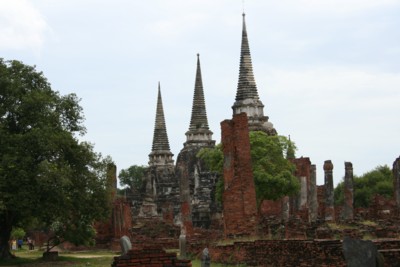 We turned right from National highway No. 32 to No. 309 on the way, and dropped in Ayutthaya ruins. Ayutthaya was a Thai former capital destroyed in 1767 by Burma. There were many huge watts in the city. Ayutthaya had had a close relation with Japan. Japan before national seclusion seemed to have had great trade to Ayutthaya that exceeded China. There, many Japanese towns flourished, but they seemed to have been destroyed by overseas Chinese for envy before long. The Japanese progenies might still live in Thailand. The taxi driver explained various things about Thailand. But if I had studied Thailand's history a little more beforehand, I could have understood the driver's explanation more.
We turned right from National highway No. 32 to No. 309 on the way, and dropped in Ayutthaya ruins. Ayutthaya was a Thai former capital destroyed in 1767 by Burma. There were many huge watts in the city. Ayutthaya had had a close relation with Japan. Japan before national seclusion seemed to have had great trade to Ayutthaya that exceeded China. There, many Japanese towns flourished, but they seemed to have been destroyed by overseas Chinese for envy before long. The Japanese progenies might still live in Thailand. The taxi driver explained various things about Thailand. But if I had studied Thailand's history a little more beforehand, I could have understood the driver's explanation more.
|
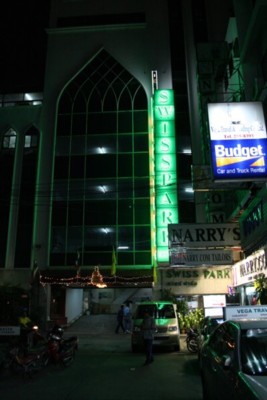
The Swiss Park Hotel |
|
And we went back to Sukhumvit Street before 16:00. Everything seemed to have begun at The Swiss Park Hotel. In this Sukhumvit, youths who came out of the country sides for poverty were living vigorously to find a dream and a hope. I thought that it was happiest for Kanung to marry with him, to get a house in her hometown and to live with him. As for me, this travel became very precious experience because I could feel from inside of Thailand (not from outside of it) that had had a deep relationship to our country in the past. We left the hotel at 20:30 for Don Muang Airport. I departed Thailand by Thai Airways International TG642 service at 23:10 to Narita Japan. Next morning, about 30 past 7, I reached Narita. I put back mobile phone to Vodafone counter in airport, I washed clothes in dormitory and went to my office from afternoon, while thinking I had to come back to this airport again to go to Dalian China tomorrow. I really thought that we should do our best to maintain relationships and trust with other countries in the world. |
|
